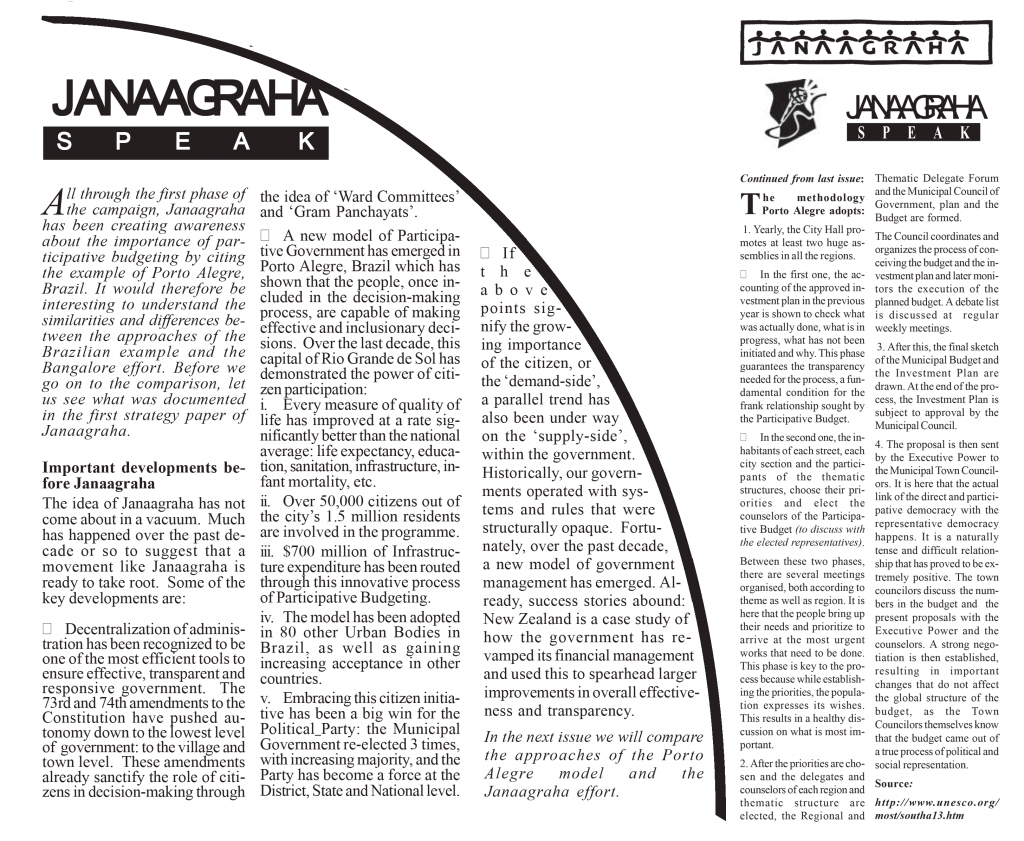
All through the first phase of the campaign, Janaagraha [Ward Works] has been creating awareness about the importance of participative budgeting by citing the example of Porto Alegre, Brazil. It would therefore be interesting to understand the similarities and differences between the approaches of the Brazilian example and the Bangalore effort. Before we go on to the comparison, let us see what was documented in the first strategy paper of Janaagraha.
Important developments before Janaagraha
The idea of Janaagraha has not come about in a vacuum. Much has happened over the past decade or so to suggest that a movement like Janaagraha is ready to take root. Some of the key developments are:
- Decentralization of administration has been recognized to be one of the most efficient tools to ensure effective, transparent, and responsive government. The 73rd and 74th amendments to the Constitution have pushed autonomy down to the lowest level of government: to the village and town level. These amendments already sanctify the role of citizens in decision-making through the idea of ‘Ward Committees’ and ‘Gram Panchayats’.
- A new model of Participative Government has emerged in Porto Alegre, Brazil which has shown that the people, once included in the decision-making process, are capable of making effective and inclusionary decisions. Over the last decade, this capital of Rio Grande de Sol has demonstrated the power of citizen participation:
i. Every measure of quality of life has improved at a rate significantly better than the national average: life expectancy, education, sanitation, infrastructure, infant mortality, etc.
ii. Over 50,000 citizens out of the city’s 1.5 million residents are involved in the programme.
iii. $700 million of Infrastructure expenditure has been routed through this innovative process of Participative Budgeting.
iv. The model has been adopted in 80 other Urban Bodies in Brazil, as well as gaining increasing acceptance in other countries.
v. Embracing this citizen initiative has been a big win for the Political Party: the Municipal Government re-elected 3 times, with increasing majority, and the Party has become a force at the District, State and National level.
- If the above points signify the growing importance of the citizen, or the ‘demand-side’, a parallel trend has also been underway on the ‘supply-side’, within the government.
Historically, our governments operated with systems and rules that were structurally opaque. Fortunately, over the past decade, a new model of government management has emerged. Already, success stories abound:
New Zealand is a case study of how the government has revamped its financial management and used this to spearhead larger improvements in overall effectiveness and transparency.
The Methodology Porto Alegre Adopts:
- Yearly, the City Hall promotes at least two huge assemblies in all the regions.
- In the first one, the accounting of the approved investment plan in the previous year is shown to check what was actually done, what is in progress, what has not been initiated and why. This phase guarantees the transparency needed for the process, a fundamental condition for the frank relationship sought by the Participative Budget.
- In the second one, the inhabitants of each street, each city section and the participants of the thematic structures, choose their priorities and elect the counselors of the Participative Budget (to discuss with the elected representatives). Between these two phases, there are several meetings organised, both according to theme as well as region. It is here that the people bring up their needs and prioritize to arrive at the most urgent works that need to be done.
This phase is key to the process because while establishing the priorities, the population expresses its wishes. This results in a healthy discussion on what is most important. - After the priorities are chosen and the delegates and counselors of each region and thematic structure are elected, the Regional and Thematic Delegate Forum and the Municipal Council of Government, plan and the Budget are formed. The Council coordinates and organizes the process of conceiving the budget and the investment plan and later monitors the execution of the planned budget.
- After this, the final sketch of the Municipal Budget and the Investment Plan are drawn. At the end of the process, the Investment Plan is subject to approval by the Municipal Council.
- The proposal is then sent by the Executive Power to the Municipal Town Councilors. It is here that the actual link of the direct and participative democracy with the representative democracy happens. It is a naturally tense and difficult relationship that has proved to be extremely positive. The town councilors discuss the numbers in the budget and the present proposals with the Executive Power and the counselors. A strong negotiation is then established, resulting in important changes that do not affect the global structure of the budget, as the Town Councilors themselves know that the budget came out of a true process of political and social representation.
Source: UNESCO – Porto Alegre Participative Budget Methodology
